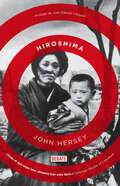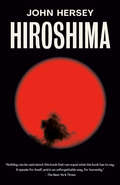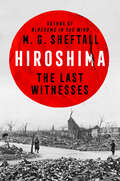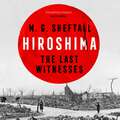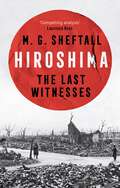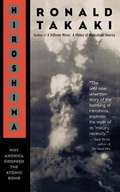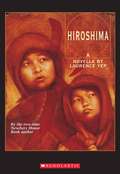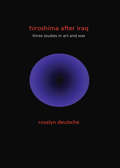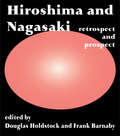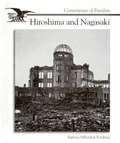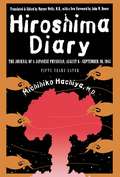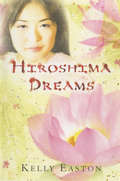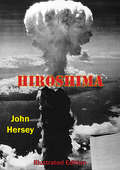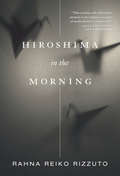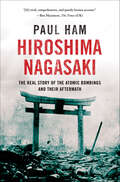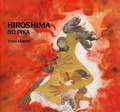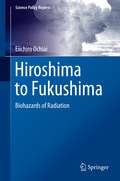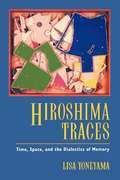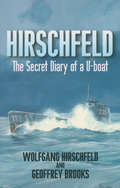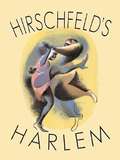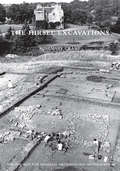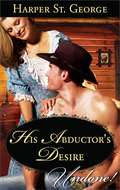- Table View
- List View
Hiroshima
by John HerseyLa crónica sobre seis supervivientes de Hiroshima que se convirtió en un gran clásico del periodismo. «Toda persona que sepa leer, debería leer este libro.»Saturday Review of Literature El verano de 1945, William Shawn, director ejecutivo de The New Yorker, habló con el reportero John Hersey sobre la idea de publicar un relato que ilustrara la dimensión humana de los efectos de la bomba atómica en Hiroshima, pues le causaba estupor comprobar que, pese a la gran cantidad de información sobre la bomba que recibían, se estaba ignorando lo que realmente había ocurrido en Hiroshima. El reportero aceptó el encargo. Hershey viajó a Hiroshima para investigar y entrevistar a varios supervivientes de la explosión de la bomba atómica, lanzada el 6 de agosto de 1945, y decidió que el retrato lo conformarían seis testimonios: una oficinista, Toshiko Sasaki; un médico, el Dr. Masakazu Fuji;una viuda a cargo de sus tres hijos pequeños, Hatsuyo Nakamura; un misionero alemán, el padre Wilhem Kleinsorge; un joven cirujano, el Dr. Terufumi Sasaki y un pastor metodista, el reverendo Kiyoshi Tanimoto. La publicación de Hiroshima trajo consigo una enorme conmoción. El reportaje se publicó en una edición monotemática de The New Yorker el 31 de agosto de 1946. La revista se agotó inmediatamente y de todo el mundo llegó una avalancha de peticiones de reimpresión. Su difusión corrió como la pólvora y en pocos meses la editorial Alfred A. Knopf lo publicó como libro, permitiendo que al año siguiente ya se hubiera traducido y publicado prácticamente en todo el mundo. En la actualidad Hiroshima lleva vendidos más de un millón de ejemplares y es un referente del periodismo de investigación y un clásico de la literatura de guerra. Es el único artículo, entre los millares de textos escritos sobre la bomba atómica, que describe cómo era la vidapara las personas que habían sobrevivido a un ataque nuclear. Y está considerado como «el más famoso artículo de revista jamás publicado». Reseñas:«No se puede decir nada sobre este libro que esté al nivel de lo que este libro dice. Habla por sí mismo y, de un modo memorable, por la humanidad entera.»The New York Times «Hay poco que se le pueda comparar en el periodismo universal.»Arcadi Espada, El País
Hiroshima (Penguin Modern Classics Ser.)
by John HerseyPulitzer Prize-winning journalist and bestselling author John Hersey's seminal work of narrative nonfiction which has defined the way we think about nuclear warfare. &“One of the great classics of the war" (The New Republic) that tells what happened in Hiroshima during World War II through the memories of the survivors of the first atomic bomb ever dropped on a city. "The perspective [Hiroshima] offers from the bomb&’s actual victims is the mandatory counterpart to any Oppenheimer viewing." —GQ Magazine &“Nothing can be said about this book that can equal what the book has to say. It speaks for itself, and in an unforgettable way, for humanity.&” —The New York Times Hiroshima is the story of six human beings who lived through the greatest single manmade disaster in history. John Hersey tells what these six -- a clerk, a widowed seamstress, a physician, a Methodist minister, a young surgeon, and a German Catholic priest -- were doing at 8:15 a.m. on August 6, 1945, when Hiroshima was destroyed by the first atomic bomb ever dropped on a city. Then he follows the course of their lives hour by hour, day by day.The New Yorker of August 31, 1946, devoted all its space to this story. The immediate repercussions were vast: newspapers here and abroad reprinted it; during evening half-hours it was read over the network of the American Broadcasting Company; leading editorials were devoted to it in uncounted newspapers.Almost four decades after the original publication of this celebrated book John Hersey went back to Hiroshima in search of the people whose stories he had told. His account of what he discovered about them -- the variety of ways in which they responded to the past and went on with their lives -- is now the eloquent and moving final chapter of Hiroshima.
Hiroshima: The Last Witnesses (Embers #1)
by M. G. SheftallThe first volume in a two-book series about each of the atomic bomb drops that ended the Pacific War based on years of irreplicable personal interviews with survivors to tell a story of devastation and resilience In this vividly rendered historical narrative, M. G. Sheftall layers the stories of hibakusha—the Japanese word for atomic bomb survivors—in harrowing detail, to give a minute-by-minute report of August 6, 1945, in the leadup and aftermath of the world-changing bombing mission of Paul Tibbets, Enola Gay, and Little Boy. These survivors and witnesses, who now have an average age over ninety years old, are quite literally the last people who can still provide us with reliable and detailed testimony about life in their cities before the bombings, tell us what they experienced on the day those cities were obliterated, and give us some appreciation of what it has entailed to live with those memories and scars during the subsequent seventy-plus years. Sheftall has spent years personally interviewing survivors who lived well into the twenty-first century, allowing him to construct portraits of what Hiroshima was like before the bomb, and how catastrophically its citizens&’ lives changed in the seconds, minutes, days, weeks, months, and years afterward. He stands out among historians due to his fluency in spoken and written Japanese, and his longtime immersion in Japanese society that has allowed him, a white American, the unheard-of access to these atomic bomb survivors in the waning years of their lives. Their trust in him is evident in the personal and traumatic depths they open up for him as he records their stories. Hiroshima should be required reading for the modern age. The personal accounts it contains will serve as cautionary tales about the horror and insanity of nuclear warfare, reminding them—it is hoped—that the world still lives with this danger at our doorstep.
Hiroshima: The Last Witnesses
by M.G. SheftallThe stories of hibakusha - Japanese for atomic bomb survivors - lie at the heart of this compelling minute-by-minute account of 6 August 1945 - the day the world changed forever as the Enola Gay dropped its payload over Hiroshima, ushering in the nuclear age. These survivors and witnesses, now with an average age of over 90, are the last people alive who can still provide us with reliable and detailed testimony about life in Hiroshima before the bombings. In this heart-stopping account they relay what they experienced on the day the city was obliterated, and what it has been like to live with those memories and scars over the rest of their lives.M. G. Sheftall has spent years personally interviewing survivors who were just adolescents at the time but have lived well into their nineties, allowing him to construct portraits of what Hiroshima was like before the bomb, and how catastrophically its citizens' lives changed in the seconds, minutes, days, weeks, months and years afterwards. Fluent in spoken and written Japanese, his deep immersion in Japanese society has given him unprecedented access to the hibakusha in their waning years. Their trust in him is evident in the personal and traumatic depths they open up for him as he records their stories.The result is a deeply human history of an unfathomable tragedy, which continues to haunt the world today.
Hiroshima: The Last Witnesses
by M.G. SheftallThe stories of hibakusha - Japanese for atomic bomb survivors - lie at the heart of this compelling minute-by-minute account of 6 August 1945 - the day the world changed forever as the Enola Gay dropped its payload over Hiroshima, ushering in the nuclear age. These survivors and witnesses, now with an average age of over 90, are the last people alive who can still provide us with reliable and detailed testimony about life in Hiroshima before the bombings. In this heart-stopping account they relay what they experienced on the day the city was obliterated, and what it has been like to live with those memories and scars over the rest of their lives.M. G. Sheftall has spent years personally interviewing survivors who were just adolescents at the time but have lived well into their nineties, allowing him to construct portraits of what Hiroshima was like before the bomb, and how catastrophically its citizens' lives changed in the seconds, minutes, days, weeks, months and years afterwards. Fluent in spoken and written Japanese, his deep immersion in Japanese society has given him unprecedented access to the hibakusha in their waning years. Their trust in him is evident in the personal and traumatic depths they open up for him as he records their stories.The result is a deeply human history of an unfathomable tragedy, which continues to haunt the world today.
Hiroshima: Why America Dropped the Atomic Bomb
by Ronald T. TakakiThe bombing of Hiroshima was one of the pivotal events of the twentieth century, yet this controversial question remains unresolved. At the time, General Dwight Eisenhower, General Douglas MacArthur, and chief of staff Admiral William Leahy all agreed that an atomic attack on Japanese cities was unnecessary. All of them believed that Japan had already been beaten and that the war would soon end. Was the bomb dropped to end the war more quickly? Or did it herald the start of the Cold War? In his probing new study, prizewinning historian Ronald Takaki explores these factors and more. He considers the cultural context of race - the ways in which stereotypes of the Japanese influenced public opinion and policymakers - and also probes the human dimension. Relying on top secret military reports, diaries, and personal letters, Takaki relates international policies to the individuals involved: Los Alamos director J. Robert Oppenheimer, Secretary of State James Byrnes, Secretary of War Henry L. Stimson, and others... but above all, Harry Truman.
Hiroshima
by Laurence YepOn the morning of August 6, 1945, an American bomber, the Enola Gay, roars down the runway of the Pacific island, Tinian. Its target is Hiroshima, Japan. Its cargo is an atom bomb.
Hiroshima
by Ran ZwigenbergIn 1962, a Hiroshima peace delegation and an Auschwitz survivor's organization exchanged relics and testimonies, including the bones and ashes of Auschwitz victims. This symbolic encounter, in which the dead were literally conscripted in the service of the politics of the living, serves as a cornerstone of this volume, capturing how memory was utilized to rebuild and redefine a shattered world. This is a powerful study of the contentious history of remembrance and the commemoration of the atomic bomb in Hiroshima in the context of the global development of Holocaust and World War II memory. Emphasizing the importance of nuclear issues in the 1950s and 1960s, Zwigenberg traces the rise of global commemoration culture through the reconstruction of Hiroshima as a 'City of Bright Peace', memorials and museums, global tourism, developments in psychiatry, and the emergence of the figure of the survivor-witness and its consequences for global memory practices.
Hiroshima After Iraq: Three Studies in Art and War (The Wellek Library Lectures)
by Rosalyn DeutscheMany on the left lament an apathy or amnesia toward recent acts of war. Particularly during the George W. Bush administration's invasion of Iraq, opposition to war seemed to lack the heat and potency of the 1960s and 1970s, giving the impression that passionate dissent was all but dead. Through an analysis of three politically engaged works of art, Rosalyn Deutsche argues against this melancholic attitude, confirming the power of contemporary art to criticize subjectivity as well as war. Deutsche selects three videos centered on the deployment of the atomic bomb: Krzysztof Wodiczko's Hiroshima Projection (1999), made after the first Gulf War; Silvia Kolbowski's After Hiroshima mon amour (2005-2008); and Leslie Thornton's Let Me Count the Ways (2004-2008), which followed the U.S. invasion of Iraq. Each of these works confronts the ethical task of addressing historical disaster, and each explores the intersection of past and present wars. These artworks profoundly contribute to the discourse of war resistance, illuminating the complex dynamics of viewing and interpretation. Deutsche employs feminist and psychoanalytic approaches in her study, questioning both the role of totalizing images in the production of warlike subjects and the fantasies that perpetuate, especially among the left, traditional notions of political dissent. She ultimately reveals the passive collusion between leftist critique and dominant discourse in which personal dimensions of war are denied.
Hiroshima and Nagasaki: Restrospect and Prospect
by Frank Barnaby Douglas HoldstockFify-three years ago the first nuclear bombs were dropped on Hiroshima and Nagasaki. They killed some 250,000 poeple. A distinguished group of contributors examine the background and effects of the bombing and look at the lessons for a world which harbours 45,000 nuclear warheads.
Hiroshima and Nagasaki (Cornerstones of Freedom)
by Barbara Silberdick FeinbergChildren's history of how the US bombed Hiroshima and Nagasaki during World War II.
Hiroshima and the Historians: Debating America's Most Controversial Decision
by null Kenneth B. PyleThe decision to use atomic bombs on Hiroshima and Nagasaki has been considered the most important – and perhaps most controversial - event in twentieth-century history. It ushered in many of the major developments of our time: the end of World War II, the beginning of the atomic age, the establishment of the American world order, and the start of the Cold War arms race. Kenneth B. Pyle illuminates both the complexities of the event itself and the debates among historians that continue today, as they wrestle with the moral issues of the decision, its necessity and its alternatives. While producing no final resolution to the controversy, historians have nevertheless advanced and deepened our understanding of this event. This accessible and thought-provoking analysis is a case study in the intricate nature of the historian's craft and a reminder of the value of historians in a free society.
Hiroshima Diary
by Michihiko HachiyaThe late Dr. Michihiko Hachiya was director of the Hiroshima Communications Hospital when the world's first atomic bomb was dropped on the city. Though his responsibilities in the appalling chaos of a devastated city were awesome, he found time to record the story daily, with compassion and tenderness. His compelling diary was originally published by the UNC Press in 1955, with the help of Dr. Warner Wells of the University of North Carolina at Chapel Hill, who was a surgical consultant to the Atomic Bomb Casualty Commission and who became a friend of Dr. Hachiya. In a new foreword, John Dower reflects on the enduring importance of the diary fifty years after the bombing.
Hiroshima Dreams
by Kelly EastonLin can't explain the knowledge she has of the future, of what people will say or what will happen. It's a gift she shares with Obaasan, her grandmother, who has recently come from Japan to live with Lin's family. But seeing the future is more than knowing whether or not a boy will call. What is Lin to make of the visions she has of a day long ago, when the atomic bomb was dropped on Hiroshima? Acclaimed author Kelly Easton's poignant coming-of-age novel about a girl with psychic abilities is rich in imagery and memorable characters.
Hiroshima [Illustrated Edition]
by John HerseyIncludes The Bombing Of Japan During World War II illustrations pack with 120 maps, plans, and photosOn August 6, 1945, Hiroshima was destroyed by the first atom bomb ever dropped on a city. This book, John Hersey's journalistic masterpiece, tells what happened on that day. Told through the memories of survivors, this timeless, powerful and compassionate document has become a classic "that stirs the conscience of humanity" (The New York Times).
Hiroshima in the Morning
by Rahna Reiko RizzutoThe award–winning author of Shadow Child embarks on a simple journey to record history that changes her life as a wife and mother.In June 2001, Rahna Reiko Rizzuto went to Hiroshima, Japan, in search of a deeper understanding of her war-torn heritage. She planned to spend six months there, interviewing the few remaining survivors of the atomic bomb. A mother of two young boys, she was encouraged to go by her husband, who quickly became disenchanted by her absence.It is her first solo life adventure, immediately exhilarating for her, but her research starts off badly. Interviews with the hibakusha feel rehearsed, and the survivors reveal little beyond published accounts. Then the attacks on September 11 change everything. The survivors' carefully constructed memories are shattered, causing them to relive their agonizing experiences and to open up to Rizzuto in astonishing ways.Separated from family and country while the world seems to fall apart, Rizzuto's marriage begins to crumble as she wrestles with her ambivalence about being a wife and mother. Woven into the story of her own awakening are the stories of Hiroshima in the survivors' own words. The parallel narratives explore the role of memory in our lives and show how memory is not history but a story we tell ourselves to explain who we are.2010 FINALIST FOR THE NATIONAL BOOK CRITICS CIRCLE AWARD&“A brave compassionate, and heart-wrenching memoir, of one woman&’s quest to redeem the past while learning to live fully in the present.&”—Kate Moses, author of Wintering"This searing and redemptive memoir is an explosive account of motherhood reconstructed.&”—Ayelet Waldman, author of Red Hook Road
Hiroshima Nagasaki: The Real Story of the Atomic Bombings and Their Aftermath
by Paul HamIn this harrowing history of the Hiroshima and Nagasaki bombings, Paul Ham argues against the use of nuclear weapons, drawing on extensive research and hundreds of interviews to prove that the bombings had little impact on the eventual outcome of the Pacific War. More than 100,000 people were killed instantly by the atomic bombs, mostly women, children, and the elderly. Many hundreds of thousands more succumbed to their horrific injuries later, or slowly perished of radiation-related sickness.Yet American leaders claimed the bombs were "our least abhorrent choice"—and still today most people believe they ended the Pacific War and saved millions of American and Japanese lives. In this gripping narrative, Ham demonstrates convincingly that misunderstandings and nationalist fury on both sides led to the use of the bombs. Ham also gives powerful witness to its destruction through the eyes of eighty survivors, from twelve-year-olds forced to work in war factories to wives and children who faced the holocaust alone.Hiroshima Nagasaki presents the grisly unadorned truth about the bombings, blurred for so long by postwar propaganda, and transforms our understanding of one of the defining events of the twentieth century.
Hiroshima No Pika
by Toshi MarukiAugust 6, 1945, 8:15 a.m. <P><P> Hiroshima. Japan<P> A little girl and her parents are eating breakfast, and then it happened.<P> HIROSHIMA NO PIKA. This book is dedicated to the fervent hope the Flash will never happen again, anywhere.<P><P> Jane Addams Children’s Book Award Winner
Hiroshima to Fukushima
by Eiichiro OchiaiSet against a backdrop of the recent disaster at the Fukushima nuclear power plant, "Hiroshima to Fukushima" examines the issue of radiation safety. The author provides important and accurate scientific information about the radioactive substances arising from nuclear power plants and weapons, including the effects of this radiation on living organisms. Currently, humankind is at a crossroads and must decide whether to phase out or increase its reliance on nuclear power as weapons and an energy source. Although a few countries, mostly European, have vowed to abolish nuclear power as an energy source, many other countries are about to increase their nuclear power programs. This book is written from a Japanese perspective and thus provides an alternative to views of Western writers. The author includes rigorous scientific analyses, however maintains a broad scope, which allows the book to be accessible to decision-makers and non-specialists.
Hiroshima Traces: Time, Space and the Dialectics of Memory
by Lisa YoneyamaRemembering Hiroshima, the city obliterated by the world's first nuclear attack, has been a complicated and intensely politicized process, as we learn from Lisa Yoneyama's sensitive investigation of the "dialectics of memory." She explores unconventional texts and dimensions of culture involved in constituting Hiroshima memories--including history textbook controversies, discourses on the city's tourism and urban renewal projects, campaigns to preserve atomic ruins, survivors' testimonial practices, ethnic Koreans' narratives on Japanese colonialism, and the feminized discourse on peace--in order to illuminate the politics of knowledge about the past and present. In the way battles over memories have been expressed as material struggles over the cityscape itself, we see that not all share the dominant remembering of Hiroshima's disaster, with its particular sense of pastness, nostalgia, and modernity. The politics of remembering, in Yoneyama's analysis, is constituted by multiple and contradictory senses of time, space, and positionality, elements that have been profoundly conditioned by late capitalism and intensifying awareness of post-Cold War and postcolonial realities. Hiroshima Traces, besides clarifying the discourse surrounding this unforgotten catastrophe, reflects on questions that accompany any attempts to recover marginalized or silenced experiences. At a time when historical memories around the globe appear simultaneously threatening and in danger of obliteration, Yoneyama asks how acts of remembrance can serve the cause of knowledge without being co-opted and deprived of their unsettling, self-critical qualities.
Hiroshima's Shadow: Writings on the Denial of History and the Smithsonian Controversy
by Kai Bird Lawrence LifschultzExamines the controversy around the use of the atomic bomb to end the war with Japan.
Hirschfeld: The Secret Diary of a U-Boat
by Geoffrey Brooks Wolfgang HirschfeldWhilst there have been many memoirs written by U-boat commanders of the Second World War, a book such as this, based upon the diaries of a senior Petty Officer telegraphist, written in 'real time' is something very special. Wolfgang Hirschfeld, whose diaries Geoffrey Brooks has translated is a born story teller. The principal chapters describe his experiences during six war patrols in U-109, in which he served as the senior telegraphist. His is a tale which covers the whole kaleidescope of emotions shared by men at war—a story of immense courage and fortitude, of remarkable comradeship born of the dangers, frustrations and privations shared and of transitory moments of triumph. Throughout runs a vein of humour, without which resistance to stress would have been virtually impossible. We get to know one of Germany's great U-boat aces, 'Ajax' Bleichrodt, holder of the Knight's Cross of the Iron Cross with Oak Leaves and, in a special biographical appendix, learn how he finally cracked under the strain. The role of Admiral Karl Donitz, the dynamic commander of the U-boat service, so fascinatingly described by Hirschfeld, is of special interest—not least because even this dedicated Nazi had clearly realized by September, 1942, that the war was fast being lost. In 1944 Hirschfeld was promoted Warrant Officer and found himself on a large, schnorkel-equipped boat (U-234) heading for Japan with a load of high technology equipment and, in addition, a quantity of uranium ore. The possible significance of that uranium has been deeply researched by Geoffrey Brooks and is discussed in a second appendix.
Hirschfeld's Harlem
by Al HirschfeldDecades before the PBS documentaries, before Bill Clinton, Al Hirschfeld went to Harlem and captured Harlem's dangerous highs and bluesy lows. Hirschfeld's Harlem opens a picture window into nearly a century of Black American artistry and life. Each drawing is accompanied by a thumbnail narrative by Hirschfeld about the most famous inhabitants and transients of the fabled streets.
The Hirsel Excavations (The Society for Medieval Archaeology Monographs)
by Rosemary Cramp"Excavations and surveys adjacent to Hirsel House, Coldstream, have revealed a remarkably detailed history of a proprietory church and its cemetery for a period when the parochial structure in Scotland was in course of development, and when very little is known about the fate of estate churches after they were donated to support the newly founded monasteries of the 12th century. The church is set in a landscape with evidence for settlement from the Neolithic to the establishment of Hirsel House, the seat of the Earl of Home. Here, in an estate the boundaries of which has changed very little since the Middle Ages, a small unicellular drystone structure developed into a well-built Romanesque church with a rare example of its bell founding structure intact. The subsequent history when the church was burnt, robbed of stone and used for domestic purposes, then finally destroyed and covered over in the late Middle Ages is graphically illustrated by the wealth of artefacts from the site. There are traces of other medieval buildings to the north of the site and the cemetery-one of the largest rural cemeteries in Scotland- provides an interesting range of burial modes, as well as, together with the environmental evidence from the site, an insight into the community which the church and cemetery served."
His Abductor's Desire
by Harper St. GeorgeMontana Territory, 1887Heiress-turned-outlaw Charity Blake is determined to get back the fortune the Davenport banking family took from her father-even if she has to hold Brent Davenport ransom to do it! After all, the seductive charmer stole something even more valuable from her five years ago: her heart. But once she has Brent in chains, Charity must face the fact that her desire for the man has grown from the sweet dreams of a young girl to the unquenchable passion of a woman. And soon it's not clear whether she's the captor, or the captive....
